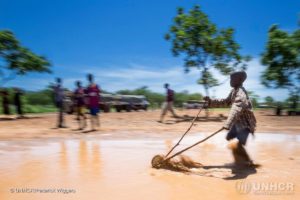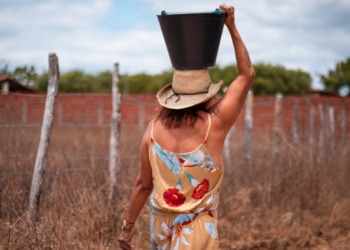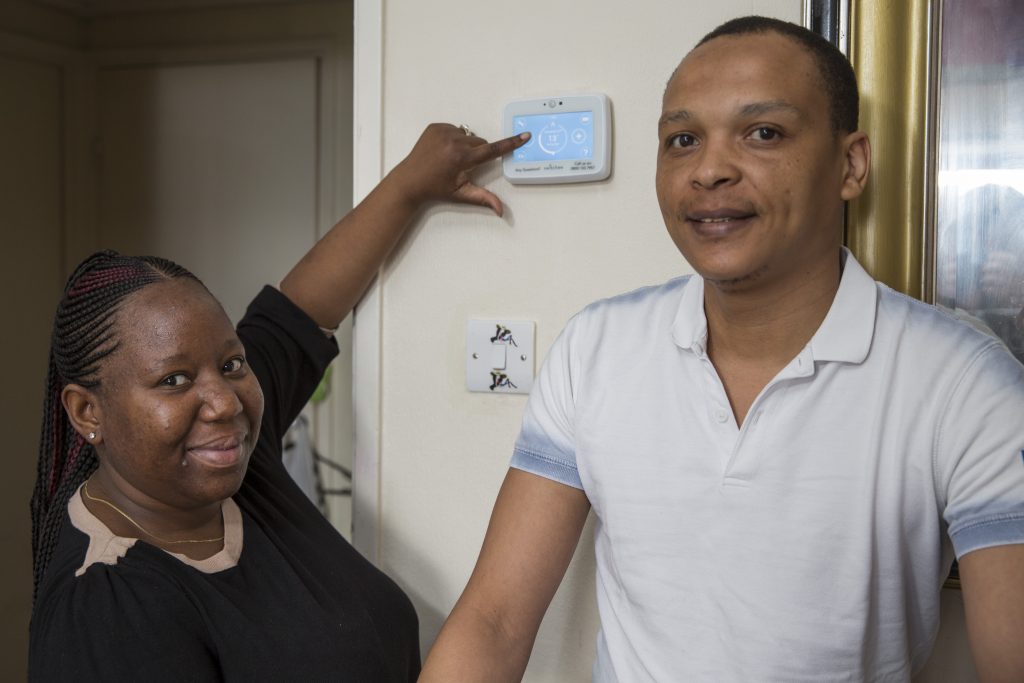INTRODUCTION
Ethiopia provides protection to 894,w000 refugees and asylum seekers from 24 countries, making it the second largest hosting country in Africa and the sixth hosting country worldwide. The largest groups are: South Sudanese (420,000) living along the Southwestern border; Somali (253,000) residing along the Eastern border, and Eritrean (169,000) living mainly along the Northern border.
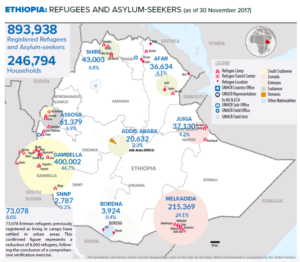
Ethiopian government policy requires refugees to reside in camps with exception to vulnerable individuals as well as for Eritrean refugees covered by the GoE 2010 Out-of-Camp policy. The government is considering expansion to respond to the new refugee influx, and in particular to those arriving from South Sudan. More than 100,000 South Sudanese have in the past year.
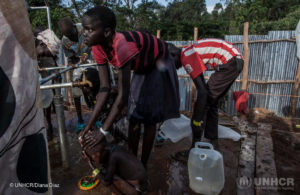
IN THE PHOTO: SOUTH SUDANESE REFUGEES USE THE WATER POINTS AT A WAY STATION IN GIMBI, ETHIOPIA WHILE EN ROUTE TO THE NEWLY CONSTRUCTED GURE SHEMBOLA CAMP. CREDIT: UNHCR/DIANA DIAZ
The UN High Commissioner for Refugees (UNHCR) and other aid agencies provide support to the Ethiopian Administration for Refugee and Returnee Affairs (ARRA) who oversees camp management, general food distribution, primary healthcare, education and other essential services. Over the last few years, the collaboration with Ministries at the Federal and State levels has grown. ARRA, UNHCR, sister UN agencies and NGO partners are increasingly relying on the technical support of line Ministries to deliver basic services to refugees in key sectors, such as education, health, child protection, and water and sanitation. This is in alignment with the global Comprehensive Refugee Response Framework (CRRF).
The issue of refugee inclusion in the national systems is at the heart of a longer-term approach that needs to be pursued simultaneously with emergency response, in order to build the self-reliance of refugees and the host population as well as the resilience of entire communities to withstand shocks and protect development gains.
Its success will be contingent upon effective joint planning, adequate donor support and an ability of all stakeholders to work side by side, in a complementary fashion, in order to deliver on the Government’s pledges aimed at ensuring a comprehensive refugee response.
REFUGEE INCLUSION IN THE NATIONAL WATER SYSTEM
Water and sanitation are at the very core of sustainable development in Ethiopia. Over the last three decades, significant investments have been made to improve access to drinking water supplies, with coverage increasing from 14 percent in 1990 to 57 percent in 2015 according to 2015 WHO/UNICEF Joint Monitoring Program. Despite this progress, challenges remain. Poor quality water, lack of proper sanitation and hygiene practices are underlying causes of malnutrition, disease, impaired growth and mortality, with children under five being at high risk. Research suggests that 1 USD invested in improving water and sanitation has a return of 9 USD in terms of avoidable deaths, more productivity due to less down-time due to illness as well as saved health costs.
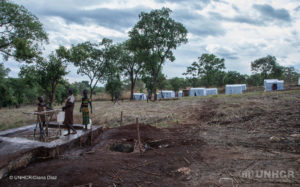
IN THE PHOTO: REFUGEES FROM SOUTH SUDAN COLLECT WATER THE NEWLY CONSTRUCTED GURE SHEMBOLA CAMP IN ETHIOPIA. CREDIT: UNHCR/DIANA DIAZ
Daily water supplies to the refugee camps are provided by the NGO partners either through water schemes or by water trucking to the camps. In 2017, 16 out of the 26 camps had achieved the UNHCR minimum standards for water provision in non-emergency settings (20 litres per refugee per day). Challenges remain as most refugee camps are located in areas with scarce water resources, high depth of groundwater, poor water quality, and long distances from source to camps. Therefore the technologies employed for abstraction, treatment and conveyance result in high unit costs. Daily 12.6 million litres of water provided on average and approximately 15 percent goes to the hosting population. A high unit cost of providing water, limited financial resources for water provision, and the complexities introduced by climate change causing cycle of drought as well as flooding, have resulted in the need to consider new models and technologies for water provision to refugees and host communities.
An existing Ethiopian law (the Ethiopian Water Resources Management Proclamation No. 197) requires that a water utility should be established for water systems serving more than 15,000 people. This law was leveraged by UNHCR and ARRA to embark on an innovative programme in Gambella region. In this programme, the public water utility of Itang town, as well as the water supply infrastructure, was established so as to be able to provide water to the host community and newly arrived refugees from South Sudan.
Using funds from KfW German development bank and others, the Itang town water supply system was constructed, and the public utility was developed. The Regional Water Bureau in Gambella and UNICEF are the two entities responsible for the project design and implementation, while ARRA and UNHCR are responsible for coordinating the in-camp works.
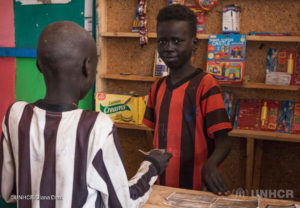
IN THE PHOTO: SOUTH SUDANESE REFUGEE CHILDREN PLAY SHOP IN THE CHILD-FRIENDLY SPACE AT NGUENYYIEL CAMP. HERE, REFUGEE CHILDREN COME AFTER SCHOOL TO PLAY, LEARN AND DO THEIR HOMEWORK. CREDIT: UNHCR/DIANA DIAZ
The analysis brought to light the huge savings in investment that could be made by expanding the national water system into refugee-hosting areas.
On average, it costs 4.49 USD (0.121 ETB per litre) to supply 1000 litres of water by trucking. The unit cost of implementing the permanent water system and operations costs will amount to 0.32-0.50 USD for same amount of water (1000 litres).
With plans underway to connect the electromechanical system to the National electricity grid and solar systems, this unit cost range will further reduce.
With the empirical evidence clearly supporting the new vision, ARRA, UNHCR, UNICEF and the Regional Water Bureau went ahead with the building of one system that spans the newly established three refugee camps (Kule, Nguenyiel and Tierkidi) and two towns (Itang and Thurfam) with a pipe network of over 120 km. The large infrastructure development, known as the Itang integrated water project, allowed for economy of scale, resulting in reduced running costs and simpler monitoring of the water quality for the entire system.
Facts:
- Some of the oldest refugee camps in Ethiopia can be found in Jijiga, where UNHCR has been providing water supplies to refugees since 1988.
- In older settlements, the often is a large percentage of the population is from the host community. For example Kebribeyah camp 70 percent of the water to host communities and only 30 percent to refugees
- For every 1 USD spent on permanent water system 5 USD is saved from current temporary water trucking in place.
- it costs 2.02 USD per month to supply 15 liters per day to a refugee by water trucking at the moment.
The new Itang integrated water system has been functioning in two refugee camps since early 2016, and is currently being extended to one additional refugee camp and two neighbouring towns.
Overall, the host community has been supportive of the project from its inception, as the piped public water supply system that served Itang town had been non-functional for many years due to failure of the electro-mechanical components. Such innovation in durable infrastructure was made possible thanks to several development partners who contributed to the Itang integrated water system.
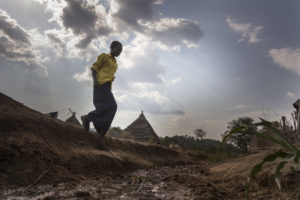
IN THE PHOTO: NYAHOK ON HER WAY TO SCHOOL. NYAHOK REATH IS A REFUGEE FROM NASIR IN SOUTH SUDAN. NYAHOK (13) LOVED WATCHING UNITED NATIONS AID PLANES TAKING OFF FROM THE AIRPORT NEAR HER HOME IN SOUTH SUDAN. NYAHOK DECIDED SHE WOULD DO ALL SHE COULD TO BECOME A PILOT. ‘I WOULD LIKE TO GO TO DIFFERENT PARTS OF THE WORLD, AND HELP PEOPLE IN NEED,’ SAID NYAHOK, WHO IS IN PRIMARY SCHOOL IN THE REFUGEE CAMP IN GAMBELLA, ETHIOPIA WHERE SHE NOW LIVES. SHE CERTAINLY HAS THE DETERMINATION, AND HER TEACHER SAYS SHE COULD MAKE THE GRADES. BUT ALONG WITH THE OTHER 127,500 REFUGEE CHILDREN IN GAMBELLA, A LACK OF FUNDING FOR FULL EDUCATION MEANS THAT HER DREAMS MAY NEVER TAKE FLIGHT. CURRENTLY, UNHCR AND ITS PARTNERS CAN ONLY PROVIDE FOR NINTH GRADE, THE FIRST YEAR OF SECONDARY SCHOOL, IN THE TWO HIGH SCHOOLS AT WHICH MOST NEW ARRIVALS HERE ENROLL. WITHOUT TENTH, ELEVENTH, OR TWELFTH GRADES, CHANCES OF GRADUATING ARE SLIM. CREDIT: UNHCR/PETTERIK WIGGERS
CONCLUSIONS
Ethiopia’s willingness to include refugees in the national water system makes it stand apart from other more traditional humanitarian responses found in other countries. In many respects, its experience is likely to shape the future of water programming in other refugee camp settings.
Ensuring safe and accessibly water supplies to both refugees and host communities help to mitigate conflict between the two groups. The experience in Gambella has prompted similar discussions in other parts of the country, including in Assosa, Jijiga, Melkadida and Shire. By having a holistic approach (involving water safety plans) and investing resources in more resilient designs for refugees, these investments can be leveraged to satisfy the needs for the host population. The value of this approach is clear: by facilitating the inclusion of refugees in the national systems, government ensures a more holistic, cost-efficient and coordinated response that can benefit both host and refugee populations alike.


![Nyawon (right), 28 and a foster mom, fills her water jugs at the communal pump nearby her temporary home at the Tierkidi Refugee Camp on 21 November 2014. ; Nyawon has taken in five abandoned children that fled the civil war South Sudan to this refugee camp in Tierkidi, Ethiopia, while she searches in vain through friends of friends contacts for her own three children that she hopes are in other camps in Uganda or Kenya. "I miss my phone. I had one in South Sudan but I sold everything I had to get here. If I had a phone, I could call and see if my children were alive. I go to collect firewood to sell and with the money I make [$2.50 every three weeks], I buy a phone card. I have to beg to use people's phones and some won't lend it, others hurry me and the line cuts or the money runs out without me getting anywhere. If I had one, I could take my time. I miss my job at home as it meant I could buy my children everything. I can't buy these children anything. We just have the clothes on our bodies. These children don't know where their parents are. I try to comfort them with the hope that they will find their parents again like I will my children."](https://impakter.com/wp-content/uploads/2018/04/rf21093_60326-1-1.jpg)
